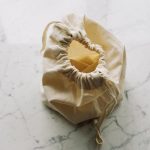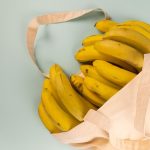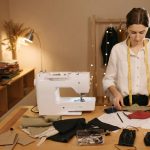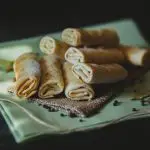Do you want to know what banana crepe fabric is? Well, you’re in luck! This article will give you all the information you need about this unique textile.
We’ll explore its origins, the manufacturing process, its properties and characteristics, and its common uses. Plus, we’ll provide you with some helpful tips on how to care for banana crepe fabric.
So, let’s dive right in and discover the wonders of this fascinating material.
Table of Contents
The Origins of Banana Crepe Fabric
The origins of banana crepe fabric can be traced back to Southeast Asia. This unique fabric is made from the fibers of the banana plant, which are extracted and spun into yarn. The production techniques for banana crepe fabric involve a meticulous process of harvesting and treating the banana plant fibers to create a soft and durable fabric.
Banana crepe fabric is known for its environmental sustainability. Unlike other fabrics, banana crepe is made from a renewable resource – the banana plant. This means that the production of banana crepe fabric does not contribute to deforestation or other harmful environmental practices. Additionally, the banana plant is naturally resistant to pests and diseases, reducing the need for pesticides and chemicals in its cultivation.
The environmental sustainability of banana crepe fabric extends beyond its production. This fabric is also biodegradable, meaning it will naturally break down over time without leaving a harmful impact on the environment. This makes banana crepe fabric a popular choice for those who are conscious about reducing their carbon footprint and promoting sustainable practices.
The Manufacturing Process of Banana Crepe Fabric
During production, banana crepe fabric is manufactured by blending fibers to create a unique texture. Here’s what you need to know about the manufacturing process of banana crepe fabric:
-
Blending fibers:
The first step in creating banana crepe fabric is to blend banana fibers with other natural fibers, such as cotton or silk. This blending process helps to enhance the strength and durability of the fabric, while also adding softness and flexibility. -
Weaving:
Once the fibers are blended, they are then woven together using specialized looms. The weaving process creates the characteristic crepe texture of the fabric, which is slightly crinkled and has a subtle matte finish. -
Finishing:
After weaving, the fabric goes through a finishing process that includes washing, drying, and sometimes dyeing. This helps to further enhance the texture and color of the fabric, giving it a more refined and finished appearance.
In terms of sustainability benefits, banana crepe fabric offers several advantages:
-
Eco-friendly production:
Banana fibers are a renewable resource that can be harvested without harming the environment. The blending process reduces the need for synthetic fibers, further reducing the environmental impact. -
Biodegradability:
Unlike synthetic fabrics, banana crepe fabric is biodegradable, meaning it will break down naturally over time.
When compared to other natural fabrics, banana crepe fabric stands out for its unique texture and eco-friendly production process. It offers a sustainable alternative to traditional fabrics while still providing comfort and style.
Properties and Characteristics of Banana Crepe Fabric
Blending natural fibers with banana fibers enhances the strength and durability of the material. Banana crepe fabric is known for its exceptional durability and sustainability. This eco-friendly fabric is made by combining banana fibers with other natural fibers like cotton or silk. The result is a fabric that not only has a unique texture and appearance but also possesses remarkable properties.
The table below highlights the properties and characteristics of banana crepe fabric:
| Property | Description |
|---|---|
| Durability | Banana crepe fabric is highly durable and can withstand regular wear and tear. It is known to have a longer lifespan compared to other fabrics. |
| Sustainability | Banana fibers are sourced from the stem of the banana plant, making it a renewable and sustainable material. The production process of banana crepe fabric also requires less water and energy compared to conventional fabrics. |
| Breathability | The natural fibers in banana crepe fabric allow for excellent breathability, making it comfortable to wear in warm weather. |
| Texture | Banana crepe fabric has a unique, slightly rough texture that adds an interesting dimension to garments and accessories. |
Overall, banana crepe fabric offers a durable and sustainable option for those who value both quality and environmental consciousness.
Common Uses and Applications of Banana Crepe Fabric
One of the most common uses for banana crepe fabric is in the production of clothing and accessories. This sustainable fabric offers several benefits when used in the fashion industry, making it a popular choice among eco-conscious consumers.
Here are some of the key benefits of using banana crepe fabric in sustainable fashion:
-
Eco-friendly: Banana crepe fabric is made from the fibers extracted from banana tree stems, which are a renewable resource. Using this fabric helps reduce the dependence on non-renewable resources and decreases the environmental impact of the fashion industry.
-
Biodegradable: Unlike synthetic fabrics, banana crepe fabric is biodegradable. This means that at the end of its life cycle, it won’t contribute to landfill waste and will naturally decompose.
-
Breathable and durable: Banana crepe fabric has natural breathability and durability, making it suitable for a wide range of clothing items such as dresses, shirts, and scarves. It allows air circulation, keeping you comfortable throughout the day.
In addition to clothing and accessories, banana crepe fabric can also be used in home decor, adding a touch of uniqueness and sustainability to your living space.
Here are some ways to explore the versatility of banana crepe fabric in home decor:
-
Cushion covers: Use banana crepe fabric to make cushion covers for your sofas or chairs. The natural texture and earthy tones of the fabric will add warmth and style to your home.
-
Table runners: Create a beautiful table setting by using banana crepe fabric as a table runner. The unique patterns and colors of the fabric will instantly elevate the look of your dining area.
Caring for Banana Crepe Fabric: Tips and Recommendations
To properly care for your banana crepe fabric, make sure to follow these tips and recommendations.
When it comes to removing stains from banana crepe fabric, it is important to act quickly. Start by gently blotting the stain with a clean cloth or paper towel to remove any excess liquid. Avoid rubbing the stain, as this can cause it to spread.
Next, mix a mild detergent with warm water and apply it to the stained area using a soft brush or sponge. Gently work the detergent into the fabric, being careful not to scrub too hard. Rinse the area with cool water and repeat the process if necessary.
To prevent shrinkage in banana crepe fabric, it is best to hand wash or use the delicate cycle on your washing machine. Use cold water and a mild detergent specifically designed for delicate fabrics. Avoid using bleach or harsh chemicals, as they can damage the fabric.
After washing, reshape the fabric while it is still damp and lay it flat to dry. Avoid using a dryer, as the heat can cause shrinkage.
Conclusion
In conclusion, banana crepe fabric is a unique and eco-friendly textile that has gained popularity in recent years. It is made from the fibers of banana plants and has a soft and silky texture.
This fabric has excellent moisture-wicking properties and is highly breathable, making it perfect for summer clothing. It is also easy to care for, requiring gentle machine washing and air drying.
Whether used for clothing, home furnishings, or accessories, banana crepe fabric offers a sustainable and stylish option for your needs.
- The Process of Custom Fabric Printing in China Explained - June 20, 2025
- Understanding the Characteristics of China Silk Lining Fabric - June 20, 2025
- Decorating With China Seas Bali Hai Fabric: a Style Guide - June 20, 2025






